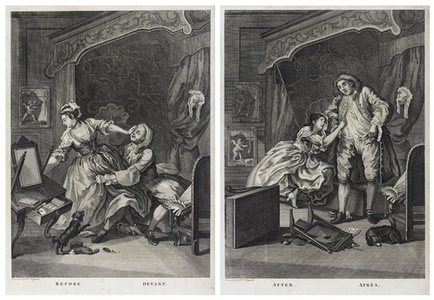| Method | Copper engraving |
| Artist | after William Hogarth |
| Published | Invented by Wm. Hogarth [Robert Sayer. London, 1767] |
| Dimensions | Images 332 x 246 mm, Plates 260 x 360 mm, Sheets 280 x 445 mm |
| Notes |
A pair of reduced engravings after Hogarth's Before and After, from Robert Sayer's Les Satyres de Guillaume Hogarth Oeuvre Moral et Comique. The plates for Les Satyres were likely engraved by John June, and published by Sayer under the auspices of Jane Hogarth, who had been granted copyright over her late husband's works by Act of Parliament. Hogarth's 'Before' and 'After,' loosely based on two sets of paintings that Hogarth completed on the theme of 'Before' and 'After,' one series set outdoors, the other indoors. The prints were evidently regarded as pornographic, or at least too risqué, as they were frequently omitted in folios of Hogarth's works, particularly the later printings by Boydell, and even in some of the sets produced by Mrs Hogarth following her husband's death. Paulson explains that in the Heath edition, they are to be found at the back, concealed in an envelope. In this reduced pair the titles are also given in French, perhaps suggesting Sayer wished to exploit or enhance the works' dubious moral reputation. The identification of the male lover is usually agreed to be Sir John Willes, Chief Justice of the Court of Pleas, who had a reputation as a 'hanging judge,' as well as being a notorious rake. Willes is also one of the subjects of Hogarth's later painting, The Bench, and its associated print. Before: The scene is that of a lady's bedroom. The lady, wearing skirts, a veil, and a pearl necklace, is unsuccessfully resisting the amorous advances of her excited lover, who pulls her towards the bed. His face is set in a lecherous leer, and his periwig is knocked off by the lady's hand as she presses her palm against his face in an attempt to avoid his grasp. His right hand grabs at her skirts while his left is hooked around her waist. In the stuggle, the lady knocks over a mirrored side table, the drawer of which opens to reveal a sermon 'The Practice of Piety.' A small dog yaps excitedly at the struggle, overturning the lady's cosmetics as it jumps up at her. Next to the large, curtained, four-poster bed a frame titled 'Before' depicts Cupid setting off a firework, a none too subtle allusion to the man's current predicament. Paulson has suggested that despite her overt display of resistance, certain clues in the image suggest that the display is actually a false show of modesty. The lady's corset has already been removed and placed on a chair prior to her paramour's arrival, and despite the sermon packed away in the drawer, the volume on the table, and thus the one she was reading prior to the scene, is a collection of the pornographic poems of Rochester, the notorious libertine John Wilmot. After: Following their romantic interlude, the enthusiasm of the couple has shifted. The lover, looking decidedly harassed and ashamed, attempts to straighten out his tousled appearance. His wig is mussed, his collar open, and his coat ruffled and unbuttoned as he attempts to do up his trousers. The lady, by contrast, cajoles him, blurry eyed, stroking his stomach and resting her head against his coatsleeves. The curtain of the four-poster has been pulled down in the excitement, the mirror has completed its fall from the upturned side-table and now lies smashed at the couple's feet, as does a chamber pot which formerly sat under the bed. The dog, worn out by all of his yapping, has curled up asleep under the chair. Another of the lady's books, a volume of Aristotle, is open to a page that reads appropriately 'Omne Animal Post Coitum Triste' ('Every creature is sad after sex'). To complete the comparison, the fall of the sidetable has revealed another picture on the wall, labelled 'After,' in which Cupid coyly points to the spent firework. William Hogarth (1697 - 1764) was born in London, the son of an unsuccessful schoolmaster and writer from Westmoreland. After apprenticeship to a goldsmith, he began to produce his own engraved designs in about 1710. He later took up oil painting, starting with small portrait groups called conversation pieces. He went on to create a series of paintings satirising contemporary customs, but based on earlier Italian prints, of which the first was The Harlot's Progress (1731), and perhaps the most famous The Rake's Progress. His engravings were so plagiarised that he lobbied for the Copyright Act of 1735, commonly referred to as 'Hogarth's Act,' as a protection for writers and artists. During the 1730s Hogarth also developed into an original painter of life-sized portraits, and created the first of several history paintings in the grand manner. Condition: Trimmed close to right hand platemark of 'Before,' as issued. Minor scuffing and dirt staining to margins, not affecting plates or images. |
| Framing | unmounted |
| Price | £600.00 |
| Stock ID | 46266 |

